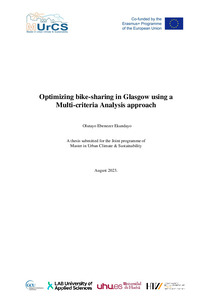Optimizing bike-sharing in Glasgow using a multi-criteria Analysis approach
Ekundayo, Olutayo Ebenezer (2023)
Ekundayo, Olutayo Ebenezer
2023
All rights reserved. This publication is copyrighted. You may download, display and print it for Your own personal use. Commercial use is prohibited.
Julkaisun pysyvä osoite on
https://urn.fi/URN:NBN:fi:amk-2023101727674
https://urn.fi/URN:NBN:fi:amk-2023101727674
Tiivistelmä
This thesis aimed to optimize the bike-sharing system in Glasgow using a multi-criteria analysis approach. Through an extensive research process, including a literature review, interviews with transportation experts, and engagement with stakeholders, a comprehensive understanding of the current state of bike sharing in Glasgow was achieved. The analysis employed a combination of Geographic Information Systems (GIS) and the Analytical Hierarchy Process (AHP) to identify suitable areas for bike station placement. Multiple criteria, such as population density, proximity to trip generators, existing infrastructure, and stakeholder input, were considered in the decision-making process. This approach ensured that the proposed locations aligned with the diverse needs and preferences of the community. By interviewing both users and non-users of the bike-sharing scheme as well as the relevant stakeholders, valuable insights were gained into the factors influencing adoption and usage patterns. This information informed the selection of suitable areas that would cater to the demands and preferences of the target user population. Additionally, the review of the literature and case studies provided a solid foundation for understanding best practices and lessons learned from similar bike-sharing initiatives around the world. The culmination of the analysis resulted in the identification of twenty-two (22) new locations as proposed sites for bike stations. These locations, as demonstrated in the maps and figures presented throughout this thesis, offer a strategic placement of stations to optimize accessibility and coverage across Glasgow. The proposed locations take into account key considerations, such as deprived regions with transport poverty, high-density housing areas, major trip generators, and existing cycling infrastructure. The findings and recommendations presented serve as a valuable resource for policymakers, urban planners, and transportation authorities in making informed decisions to promote sustainable mobility and enhance the urban environment.
